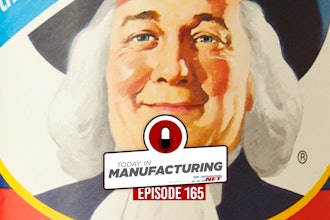On Dec.15, 2009, the Obama administration released an industrial policy paper entitled “A framework for revitalizing American manufacturing.” This paper is the first written policy to address specific manufacturing problems. The administration should be commended for this effort, but to turn the paper into a true industrial policy for American manufacturing in the long term, it needs to address some very specific problems and have numerical goals.
If I was the President’s manufacturing advisor, I would suggest the following modifications to his seven written policies:
POLICY 1 -- Provide workers with the opportunity to obtain the skills necessary to be highly productive. It is crucial that these skills be relevant. Our education system must provide access to the skills that are needed for the jobs and the industries where we can compete.
Problem: Most of the money goes to improving grade school, high school, community colleges, and 4-year college programs. Improving the schools is important, but manufacturing has a more pressing problem -- replacing the 10 million skilled workers that will retire by 2020.
The policy mentions high quality job training, however, I know from my own research that the two federal projects that are supposed to provide money for manufacturing training do not offer enough money or the advanced training that we need.
The High Growth Job Training Initiative is a strategic effort to prepare workers to take advantage of new and increasing job opportunities in the 14 high growth and high demand industries in the U.S. economy, which includes advanced manufacturing, aerospace, automotive, and construction. A list updated in January 2009 shows $75 million issued for 31 grants under the advanced manufacturing part of the HGJTI. However, only $6.9 million was invested specifically in apprentice-type training.
The other major program is the Workforce Investment Act, which is the program with the biggest budget for training (approximately $7 billion per year). The Department of Labor funnels the money for training through workforce investment boards in each state.
In looking at their website and the budgets shown on the Federal Register, it appears that most of the money is for youth activities, adult activities, dislocated workers, employment services, workforce information grants, and work opportunity tax credits. Not very much of this money goes to advanced manufacturing training.
People don’t realize that replacing the 10 million manufacturing workers who will retire by 2020 will require advanced training programs and many more apprentice programs to produce highly skilled workers.
POLICY 2 -- Invest in the creation of new technologies and business practices. Our efforts in this area should focus on advanced research without immediate commercial application, where private companies are likely to under-invest. Finally, the government has a role to play in helping to bring to scale emerging technologies, as well as facilitating the diffusion of business practice innovations that can help American manufacturers compete.
Problem: Focusing the government money on advanced research is a great idea, but the federal government contribution in 2008 was only $99 billion, or 25 percent of the total R&D forecast. Before 1980, the federal government supplied the largest share of R&D funds. Today, industry R&D is almost 3 times the funding of the federal government. The federal R&D budget has had very little growth for the last 10 years and is simply not adequate to help manufacturing
In the last eight years, the federal government has shifted basic research dollars from the physical sciences to the life sciences. This is great for the biotechnology industries and health sciences (including pharmaceuticals), but it has short-sheeted the other basic manufacturing industries, like autos, machinery, and automation.
POLICY 3 -- Develop stable and efficient capital markets for business investment. We need to structure our capital markets in such a way that those who wish to invest in the equipment and facilities necessary to make labor productive can access the credit to do so.
To develop stable and efficient markets for business investment, the U.S. government has committed to providing access to capital for new businesses through the Small Business Administration (SBA) and ensuring access to capital for exporters through the Export-Import (EXIM) Bank. There are also Department Of Energy 1703 and 1705 loan guarantees. DOE loan guarantees can back financing for factories that make wind turbines, solar panels, energy efficient windows, and other clean energy equipment.
This policy goes on to create a financial regulatory system that works. Significant reforms are needed to ensure that businesses, investors, and consumers have access to stable capital markets.
Problem: This policy is very vague and doesn’t specifically explain the regulation that is needed to prevent another financial crash or to get them to expand credit. Also, many manufacturers who have dealt with the SBA and EXIM Bank find these organizations bureaucratic and slow.
The specific language of these loan guarantees needs to spell out that American companies should hire American workers to get these guarantees. There are a number of stories about solar panel and wind turbine manufacturers who are getting government subsidies and farming the work out to China.
POLICY 4-- Help communities and workers transition to a better future. We must recognize that just as manufacturing has traditionally provided a significant employment base for many communities; it is particularly painful for these communities when factories and industries can no longer employ large numbers of workers.
In these situations, the government should help both the affected workers and the community transition to activities that can sustain them in the future. The solutions to this problem are to:
• End the rush to plant closures
• Support the creation of competitive communities by promoting regional innovation
• Expand Trade Adjustment Assistance (TAA)
Problem: To end the rush to plant closures the policy suggests Obama supports extending the notification period for plant closings from 60 days to 90 days, asking companies to engage with local, state, and federal governments to explore potential alternatives to plant closing. Giving communities more notice is going to have little effect. The real answer is to find ways to prevent the closings which gets back to doing something about the trade deficit.
Another issue is that the $50 million suggested for regional innovation will be spent on community, education and economic development organizations (which will mostly be spent on overhead). The money should be allocated directly to manufacturers to allow them to find the ways to promote regional innovation. Giving money to these institutions will not create regional innovation -- it will create the illusion of innovation.
POLICY 5 -- Invest in an advanced transportation infrastructure. The competitiveness of American manufacturers depends critically on a modern, reliable and efficient infrastructure so that goods, energy, people and information can move cost-effectively from one place to another.
Problem: I don’t think anybody is against the ideas of investing in our nation’s roads, bridges, mass transit, batteries and electric drive components for transportation electrification, the Electric Grid, building high-speed rail, developing the next generation of air traffic control, and expanding access to broadband. However, all of this work should go to American manufacturers and should ensure that all parts and materials are purchased in America.
POLICY 6 -- Ensure market access and a level playing field. We must be sure that those who wish to sell the goods that they make in the U.S. into other countries have the market access they need, and that those who sell domestically do not face unfair competition from advantaged foreign producers.
Problem: American manufacturers cannot thrive without opening up markets abroad. However, some foreign markets restrict American exports due to high tariffs and various non-tariff barriers.
The only truly free markets are in the U.S., and our free trade policies of the past have been one-sided and led to the de-industrialization of America. Protectionism is not the answer, but we need to negotiate a level playing field where all of our trading partners open their markets the same as America does.
This should begin by simply enforcing our laws on intellectual property, unfair dumping, and foreign subsidies to penetrate America’s markets. But the most important problem in terms of a level playing field is to stop China and Japan from manipulating their currencies.
The report says “With its network of trade specialists in over 100 cities across the United States, commercial experts in more than 75 countries around the world, and industry and trade policy analysts in the nation’s capital, the Commercial Service at the Department of Commerce is helping U.S. firms become more globally competitive, breaking down barriers to trade, and facilitating expansion of exports by U.S. firms.”
However, the network of trade specialists in offices all over the world has done very little to help small and midsize manufacturers become exporters. Before increasing the budget of the Commercial Service, the government needs to really examine what is preventing those small and midsize manufactures from going after foreign markets.
POLICY 7 -- Improve the business climate, especially for manufacturing. Consistent with our desire for clean air, water and reducing the release of greenhouse gases, as well as the need for fiscal responsibility, we need legal, tax and regulatory regimes that promote American manufacturing and don’t place an undue burden on those who wish to manufacture products in America. This policy includes slow cost growth through health reform. Health care costs are a huge problem for manufacturers and all businesses.
Problem: It appears that the health care legislation currently in Congress is not going to reduce premiums or health care costs but will expand coverage to more people.
Replace tax breaks for overseas investment with tax cuts for businesses creating jobs in America. Obama is committed to curbing tax incentives that give a company a lower tax rate for creating jobs overseas than it receives for creating jobs in America. The tax credits should be given to companies who create American manufacturing jobs or bring back jobs from overseas.
Moreover, America’s swelling budget deficit has reduced the national savings rate to the lowest level since the 1930s, cutting the capital available for American businesses, increasing foreign borrowing and swelling the trade deficit.
This is perhaps the most important policy for American manufacturing. The majority of the trade deficit is imported oil and China imports. If the administration could get China to quit manipulating its currency, it would do more to grow manufacturing and create more manufacturing jobs than any other policy in the plan.
Compared to previous administrations, this effort by the Obama administration to revitalize manufacturing is a great effort and the first time I have seen government define most of manufacturing’s problems. It is a good platform to develop a true industrial policy to match those of European and Asian countries.
My last suggestion for what is needed to make this a comprehensive manufacturing industrial policy is the commitment to growth in terms of manufacturing jobs and manufacturing as a percentage of GDP.
Jeffrey Immelt, chairman of GE, suggests the employment goal should be to double the manufacturing employment from 10 percent to 20 percent of total employment by 2020. Manufacturing as a percentage of GDP is around 10-11 percent. If we are truly going to revitalize American manufacturing, I suggest to the administration that the goal should also be to double this percentage to 20 percent of GDP by 2020.
With these measurable objectives and the policy changes suggested in this article I think we would have an industrial policy that could revitalize American manufacturing.
Michael P. Collins is president of MPC Management, a manufacturing consulting company, and the author of the book, “Saving American Manufacturing."






















